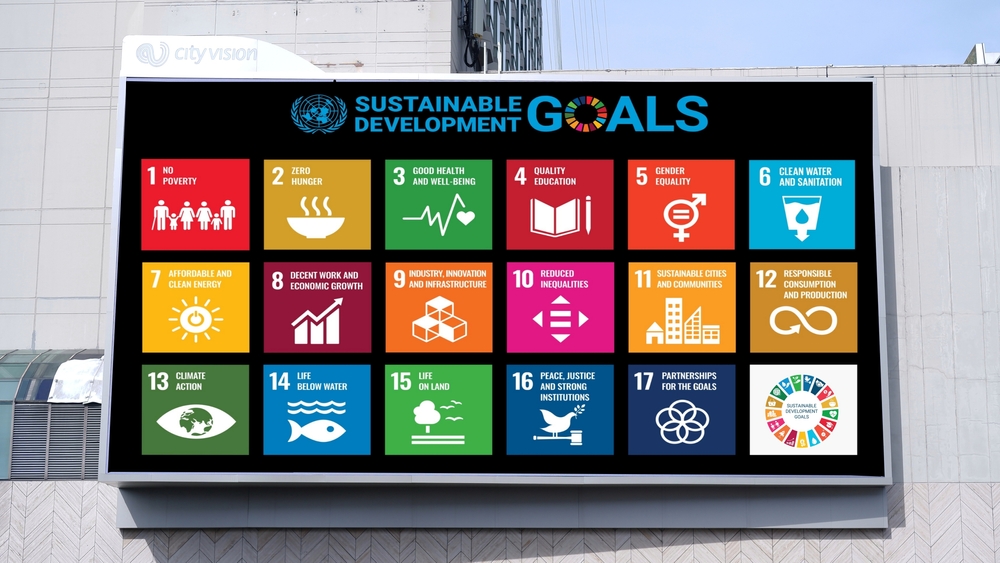Looking at the global picture, progress across the Goals is not equal across geographies and income groups. Higher income levels, along with a functioning and stable state that uses resources for the benefit of its population, are two critical factors in SDG progress. The nature and impact of public spending matter as much as the level of spend. Public spending is most effective when shaped by evidence and research. Innovation and rising productivity are key to sustainable, inclusive economic growth that does not exacerbate climate risk or increase inequality.
There are multiple international initiatives which aim to accelerate SDG delivery. The UN’s High Impact Initiatives identify six key transitions that have a multiplier effect across the SDGs. The UN SDSN’s Transformations work also identified six areas for immediate SDG action. The SDG Synthesis Coalition produces rigorous syntheses, systematically collating evidence on how to progress the SDGs. Other non-UN led initiatives, such as ONE’s accelerators, similarly look at how to turbocharge SDG delivery. Consistent themes across many of these initiatives are gender equality, climate action, education, and technology. These initiatives shine a spotlight on the need to accelerate SDG delivery, though they can present challenges as actors are not clear if/how the initiatives are interconnected or complimentary, and whether they have a strong evidence base.
Sharing success stories and lessons learnt from different country contexts helps build both a shared understanding and the evidence base on what works to deliver the SDGs. The following four country case studies illustrate outstanding examples of national and local actions. Common learnings and best practice across the case studies demonstrate the importance of mainstreaming SDGs across national development plans and budgets, integrating SDGs into national and local governance processes, and civic, private sector and local community engagement. In many cases, developing countries have been highly successful in mainstreaming SDGs at national, regional and local levels. Recognising the universality of the SDGs, other countries including developed countries, may consider enacting similar policies and approaches.
-
Case Study: Indonesia
As a foundation for SDG delivery, Indonesia has strengthened regulation and governance. This is complemented by investing in multistakeholder partnerships and localising the SDGs. By mainstreaming 124 of the 169 SDG targets, including its indicators, into the National Development Plans, developing regional SDG action plans, and creating SDGs Centers /Hubs now at 47 local universities, the SDGs have been embedded across the multiple levels of policy making and financial planning. An SDG roadmap was created and the interlinkages between SDGs were identified, highlighting that health, water & sanitation, education, inequality, energy and environment are particularly synergistic. The SDGs interlinkages serve as a basis for identifying priorities at both the national and provincial levels. Avoiding silos, more work at local & regional levels, increasing private sector engagement, and using the same KPIs across government and other partners were all seen as helpful lessons learnt.
-
Case Study: Ghana
Through a whole of government and whole of society approach, Ghana has put the SDGs at the core of its development planning and development management processes. The SDGs are fully integrated into the overarching national development framework and the country has adopted SDG-based budgeting to track expenditure flows in support of SDGs implementation. The country has established a robust governance architecture made up of multiple stakeholders to oversee the implementation of the Goals, including a High-Level Ministerial Committee, an SDGs Implementation Committee, and a National Technical Committee. The private sector and civil society are active participants in this, working together with the government in this shared endeavour. The government has been intentional in implementing strategic flagship programmes that directly contribute to achieving multiple SDGs. A notable case in point is the national school feeding programme, whereby free meals provided at schools have increased school enrolment and attendance at basic schools, reduced school drop-out rates, reduced malnutrition among children, improved educational outcomes, reduced inequalities and created employment opportunities in the local communities.
-
Case study: Mexico
The National Development Plan for Mexico is intrinsically linked to the SDGs, whilst Federal Budget is bound to SDGs and its targets since 2019. Shared goals are embedded in the budget plan at every level, from the federal to programme budgets. At each level, the work must explicitly be directly or indirectly contributing to the SDGs. The importance of leaving no one behind, and equal opportunities for all, for example reducing regional differences, is seen as critical. The SDGs have been institutionalized into the lifeblood of Mexico’s operations through strong governance, multiple national and local voluntary reviews, and extensive collaboration across government, civil society, and beyond. The agroforestry programme, Sembrando Vida (Sowing Life), is an example of how the two issues of rural poverty and environmental degradation can be tackled simultaneously, having a positive impact across multiple SDGs. Mexico refers to these as ’round’ programmes; programmes that hit all three aspects of sustainability simultaneously.
-
Case study: Nepal
Nepal has succeeded in making progress on the SDGs through close alignment of the Goals with domestic policies and governance processes. The SDGs are mainstreamed across the national development plan and the budget. For example, Nepal’s 16th development plan (2024-2030) was designed based upon previous successes and learnings, and aims to accelerate the SDGs through good governance, social justice and prosperity. The SDG framework is embedded throughout different levels of government, for example through local level planning guidelines, robust governance mechanisms and implementation monitoring. Nepal has reflected upon its SDG progress and lessons learned, noting hurdles in localising the SDGs, plugging the financing gap, and building greater civic SDG awareness amongst rural populations.
